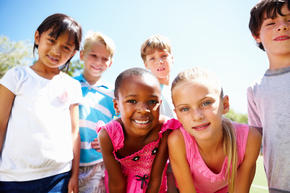
For some children, the first day of kindergarten is also the first time they will meet people from other cultures, religions and races. Understanding that not all children look the same, act the same, or believe the same thing can be shocking for young learners. As a teacher, try using the following strategies to teach about diversity and differences.
Diversity and Acceptance
Reading picture books aloud is one of the best ways to introduce new topics, such as diversity and acceptance. One of the all-time best books, The Crayon Box that Talked, uses rhyme and metaphor to illustrate the importance different colors play in creating a magnificent picture. Just like in the real world, if we all looked identical, everything would be dull and boring. Other stories, such as How the Zebras Got Their Stripes, and, I Love Being Me, are good examples of children’s literature that teach about acceptance without a harsh adult message. The story of Elmer the Elephant can be a great way to help children gain confidence in themselves. By allowing your class to decorate their own elephant in colorful and elaborate ways (he is plaid in the book), they can visually see how special everyone in their class truly is! Picture books are an easy way to get a complicated message across to young minds. Concepts such as racism, prejudice, and inequality are often too complex for young readers to comprehend.
Equal but Different
A great misconception is believing that something of difference is less worthy. It is very challenging to understand that two things (or people) can be complete opposites, yet perfectly equal in value. One activity to help children see that we are all equal is the egg experiment, in which a brown egg and a white egg are cracked to reveal that inside the yellow and white yolk is exactly the same. Moreover, when cooked, both eggs taste the same regardless of the color of their shell. Mem Fox’s book Whoever You Are also helps illustrate the vast similarities between children all over the world. She writes about how all children laugh, play, cry and bleed the same—no matter what color skin they have or what country they live in.
Encourage Positive Conversations
One last note is to help students understand that words can be very powerful and once something negative has been said, it can never be taken back. At this young age, children will naturally have numerous questions when first encountering a child of another race, ability, or religion. For young learners, differences can be scary at first, but when given the opportunity, they can be incredibly powerful teachable moments. To start, giving children sentence frames such as “I was wondering if you could tell me more about….” will engage them in positive conversations without hurting anyone’s feelings. Another activity is to cut out a life-size person from brown butcher paper. Have each child rip a piece of the person if they have ever been ridiculed or have felt ashamed about themselves. Then try to put the pieces back on the person with tape. This tape symbolizes saying “I’m sorry” because even though it helps, it can never make the person completely whole again. Hang the taped-up person in the room as a reminder not to rip each other apart with mean words.
Here are more lesson plan ideas to expand children’s thinking:
Properties of Color
This is a science lesson based on primary colors. Although, it does not deal directly with diversity, it would be a great introduction to a unit of study on racism or tolerance among different cultures.
Box of Crayons
Here is a great visual arts lesson plan in which each child can decorate a crayon to represent himself/hersel. All the crayons are assembled into a box for a great classroom bulletin board.
Diversity of Families
Young learners can research and write about what makes their family special and unique. This lesson plan includes a cute, age-appropriate poem to display in class.

